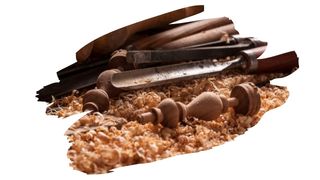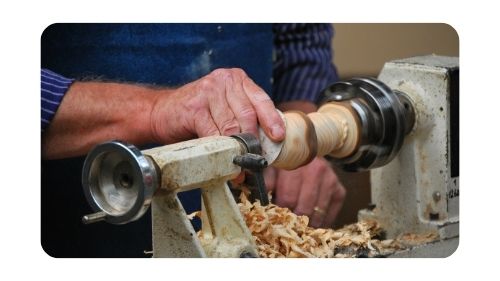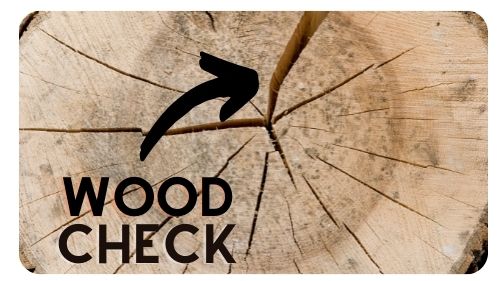Are you looking for a hardwood that’s perfect for woodturning?
Well, Oak is a rather dense hardwood. And choosing a lighter-weight lumber would be easier to turn – and less harsh on your wood lathe.
But besides that? What are we generally looking for in a good block of turning wood? Well, there are three key things;
- Strong visible wood grain – with a pattern that’ll make your final piece look incredible.
- The timber is easy to turn when dry – so that you don’t have to deal with wood cracking as you turn.
- A lumber that can take on a coat of stain or finish – without leaving blotchy results.
So, when it comes to those three key factors, how does Oak wood measure up? Is that Oak block really any good for turning?
Oak isn’t a first choice turning wood. You see, Oak wood, shrinks a lot as it dries. And that shrinkage causes Oak to crack and form checks on the grain. Oak is also very solid and hard when its dry as well. And while its unyielding nature might make it great for hardwood floors, it is going to make life very difficult for your wood lathe.
What Are Wood Checks? Wood checks are when wood splits open across the grain.
Now, having said all that, that doesn’t mean you should always cross Oak off your lathe-lumber list.
So, if you have your heart set on crafting Oak into something amazing, here’s what you need to know about turning this hardwood…

This post may contain affiliate links to products that we receive a commission for (at no additional cost to you). Learn more here.
If It’s Not Oak, What Is The Best Timber Wood For Turning?
As a beginner, any affordable (or free) wood you come across can be worth it just for that turning practice.
Whether it’s a log from your back yard, or a wood block from the hardware store, they’re all good enough to practice with.
For example, Poplar wood is great for refining your technique with. It’s fairly soft for a hardwood, easy to get a hold of, and doesn’t need much elbow grease to get going with this lumber.
However, Poplar doesn’t have much grain definition, and doesn’t take stains or finishes well. So as a final craft project, it’ll suffer from looking very plain.
But, if you want wood that is simple to turn, looks great, and finishes easily, then get some Walnut.
Walnut lumber won’t split open the way Oak does. This is because it doesn’t shrink anywhere near as much (in comparison) as it dries.
Walnut wood grain – especially Black Walnut grain – has spectacular color that you won’t want to change or stain. But, if you did, this lumber can take on oil finishes evenly.

So, Does This Make Oak Wood The “Worst” Wood For Turning?
No, not even close. The answer to the worst woodturning wood is simple… it’s pallet wood.
And it doesn’t even matter what type of natural wood that pallet lumber was originally made from (which is usually Oak or Pine).
The toxic chemicals, (namely Methyl Bromide – which was used to treat a lot of old ‘MB-stamped’ pallet wood), is not something you want flying around in inhalable particles in your workshop.
Plus, pallet wood is just so gosh-darn dry! Every ounce of moisture – and some more besides – has been wicked away from it long before you get a chance to work with it.
Related Post: Is Oak Wood Any Good For Making Cutting Boards?
And Is It Better To Turn Green Oak Wood Or Dry Oak Wood?
Either one is as fine a state as any to carve Oak wood in. Just as long as you know what you are in for:
- Dry wood is more stable and faster to work with. And you don’t need to wait for the wood to dry out once you’ve finished turning it.
- Green wood, on the other hand, is easier to cut. Also, it doesn’t wear down your tools as much as dry wood does. Which is why it is preferred for everyday whittling and wood carving.
But, remember back when we mentioned that Oak notoriously likes to shrink as it dries creating those troubling check issues?

Well, that shrinking process means you won’t just have cracks and checks to worry about. You’ll also have to deal with the dimensions of your craft being thrown off kilter as well.
So, with that in mind, working with dry Oak wood beats out working with green wood.
How Long Does Oak Wood Need To Dry Before Turning? As long as it takes for its moisture content to drop to below 20%. This can take mere weeks, or even months, depending on the time of year. To learn more about seasoning wood, (and how you can speed things up), check out our post: How To Season Wood (7 Tips)
So To Sum Up…
At the end of the day, because of its tendency to crack, Oak would is better off used as a practice wood. In other words, there isn’t much point in choosing Oak for your woodturning masterpiece. It’ll be too frustrating to work with.
And, if that’s the case that you are on the lookout for practice wood, then there are loads more affordable options out there.
Which means, that unless you can get your hands on a bit of free Oak, it’s not really worth turning this lumber.
Related Post: Is Oak Wood A Good Choice For Chainsaw Carving?
References
The shrinkage of oak predicted from its anatomical pattern.
Systemic effects of inhalational methyl bromide poisoning.
Methyl bromide is a fumigant used to control pests in agriculture and shipping.

